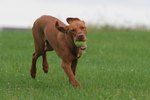With a name meaning "badger dog," you can expect nothing less from a dachshund than a stubborn, feisty, loyal canine companion. Doxies were bred to have short legs and long, narrow bodies suitable for burrowing into holes and flushing out varmints. However, their unique body shape puts dachshunds at a high risk for suffering degenerating disks, a condition known as intervertebral disk disease. Understanding IVDD can help you reduce your dachshund's risk of developing the condition and seeking prompt veterinary attention should symptoms occur.
About IVDD
Dog spines have of an average 26 intervertebral disks that lie between the spinal vertebrae and act like shock absorbers for the spine. Each disk consists of two parts: the outer tough, fibrous covering, called the annulus fibrosus, and the inner, gel-like substance, known as the nucleus pulposus. Over time, the disks degenerate, lose some of their moisture content and calcify, which makes the disks hard and brittle rather than flexible and elastic. When stress is put on the disks, they can rupture, which forces the nucleus pulposus through the annulus fibrosus and lodges it into the spinal canal that encases the spinal cord. The narrow canal compresses the spine so the new substance can fit, which injures the cord or spinal nerves and causes a wide range of symptoms.
Dachshunds and IVDD
About 25 percent of doxies experience this spine-related health issue in their lifetime. The dogs are predisposed to develop intervertebral disk disease, sometimes called or intervertebral disk herniation, because their disks degenerate more quickly than other breeds. In fact, around 90 percent of doxies have experienced some disk degeneration by the time they turn 1. Although the disease can strike at any time, about 80 percent of doxies develop IVDD between the ages of 3 and 7. With their genetic predisposition, dachshunds frequently suffer from multiple herniated disks. In fact, 5 to 20 percent of doxies will experience IVDD within two years of the first incident.
IVDD Signs and Symptoms
Although signs of IVDD vary according to which disk ruptures and the amount of damage it inflicts to the spinal cord, most ruptures follow the same pattern. Dogs initially experience back or neck pain. Your doxie might seem reluctant to walk, stand, jump, climb stairs or turn his head. His back legs will grow weaker. He may become so wobbly that he will walk like a drunken sailor. Your dog might cross his back feet or knuckle his paw, which means he stands or walks on his knuckles with his toes pointing backwards instead of on the pads of his feet. If left untreated, affected dogs become paralyzed in their back legs.
Other symptoms might include restlessness, appetite loss, incontinence, insomnia, a tight or tender abdomen or back and yelping in pain when he moves or when you pick him up. Injured dogs often hunch over, hang their heads and shake, tremble or shiver.
Diagnosing IVDD
Your vet will need the help of advanced imaging tools to find out which disk is pressing on the spinal cord. Some vets use magnetic resonance imaging while others use a CT scan. Still others choose to inspect the spinal cord via a myelogram, which is a special type of X-ray that occurs after the vet injects dye around the spine so he can find the compression. Your vet may pinch the toes on your dog's rear legs to see if he reacts to pain. Although that might seem cruel, dogs who still feel deep-tissue pain have a much better prognosis than those who don't. Early detection is crucial; call your vet immediately if your dog shows any symptoms of IVDD.
After your vet diagnoses your doxie with IVDD, he will suggest what actions to take. Dogs with mild spinal injuries often are treated successfully with corticosteroids and being confined to a crate for six to eight weeks. If your doxie can't walk or stand, he likely will need an expensive surgery to remove the disk material compressing the spine.
Reducing the Risk
Despite his genetic predisposition, you can reduce the risk of your doxie suffering from IVDD by making a few lifestyle changes. Although doxies are stubborn little dogs, you must train him to avoid high-impact activities, such as climbing stairs and jumping up to greet people, begging or jumping off furniture. Use a baby gate to block off staircases and purchase or build plywood ramps covered with a nonslip surface. Place the ramps so your doggy can get on your bed and his favorite chair or couch unassisted.
Obesity increases the risk of IVDD and doxies are known gluttons. Watch his diet closely. Follow the recommended portion size listed on the dog food label or given to you by your vet. Limit treats or people food. Take him for regular walks to keep him fit and lean, but hook his leash to a harness rather than a dog collar. The harness spreads the pulling stress out over his chest rather than focusing the force on his spine and neck.
References
- InTown Veterinary Group: Dachshund and Intervertebral Disk Disease
- American Kennel Club Canine Health Foundation: Overview of Intervertebral Disk Disease (IVDD)
- Nashville Veterinary Specialists and Animal Emergency: Thoracolumbar Intervertebral Disc Disease
- Michigan State University Veterinary Medical Center: Dachshunds and IVDD
- NorthStar Vets: Ask the NorthStar VETS Vet: Avoiding Back Problems in Dachshunds
- Dr. Jeff Nichol: Dachshund Back Problems
- Washington State University: Intervertebral Disk Disease
- American College of Veterinary Surgeons: Intervertebral Disc Disease
Photo Credits
-
OndrejVladyka/iStock/Getty Images





